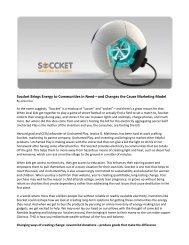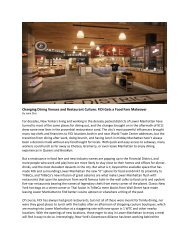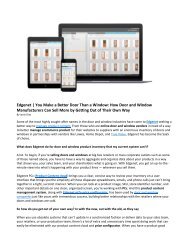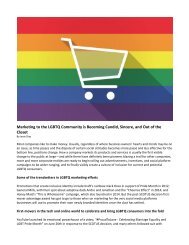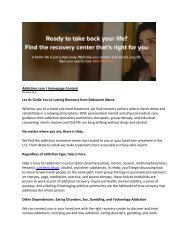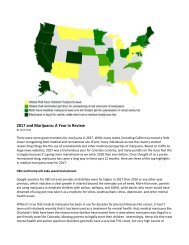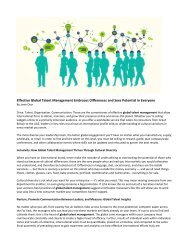2016 Office Design Trends Transparency by Janie Diaz
A discussion about how the workplace is changing and how employers and office-space owners can reconfigure the space they offer workers to stay on-trend. Also available here: https://www.avantisystemsusa.com/2016-office-design-trends/
A discussion about how the workplace is changing and how employers and office-space owners can reconfigure the space they offer workers to stay on-trend. Also available here: https://www.avantisystemsusa.com/2016-office-design-trends/
You also want an ePaper? Increase the reach of your titles
YUMPU automatically turns print PDFs into web optimized ePapers that Google loves.
<strong>2016</strong> <strong>Office</strong> <strong>Design</strong> <strong>Trends</strong> <strong>Transparency</strong>, Greenery and Healthier Company Culture <strong>by</strong> <strong>Janie</strong> <strong>Diaz</strong><br />
In <strong>2016</strong>, there are many progressive, fresh themes driving workspace design and layout. With many small businesses and large enterprises going<br />
increasingly greener, many are making the most of the space they have to lower the cost of overhead. But there’s more to the design trends in the<br />
office than smart use of space and being eco-friendly. Most businesses want to save money, but what’s driving the look of office spaces more than<br />
anything are the changes to workplace culture, how we work with one another within these spaces, and how utilitarian we can make them while<br />
maintaining modern appeal.
Expanding on Fishbowl Workspaces: The New Transparent Company Culture<br />
Elite Freestanding with Eclipse Sliding Barn Door : View Derse Case Study<br />
Using glass walls and partitions has been part of many office spaces since the 1960s, but never to the degree we see it today. Just as culture<br />
outside of company walls has become more transparent because of social media and generally fewer collective constraints, so too are<br />
workspaces literally becoming less exclusivist. With many enterprises of all sizes creating inclusive workspaces that allow for more groupthink,<br />
less frequently are we seeing heads of departments sequestered off in some unapproachable corner office. Workers executing everyday tasks<br />
and applying themselves to time-critical, one-off projects are clearly visible to their managers, supervisors, or even the CEO.<br />
The fishbowl concept makes the entire office accessible <strong>by</strong> using more glass doors, walls, windows, skylights, and other ways to allow in more<br />
natural light and create a more welcoming atmosphere. With more communication between higher-ups and worker bees, today’s fishbowl work<br />
environments foster better communication — the lines between roles are blurred in a way that is advantageous to meeting deadlines, reducing
conflict, and lessening feelings of alienation among the ranks. The clearer things are literally, the clearer a team’s objectives become. Accordingly,<br />
for many companies across a wide range of industries, the fishbowl concept has been given a 21st century facelift. <strong>Transparency</strong> enhances<br />
workflow, trust, and communication among those in every role and station in the office.<br />
Forget the Concealed Conference Room: Auditoriums and Wide-Open Workspaces<br />
Elite Freestanding with Eclipse Sliding Barn Door<br />
The age of the cloistered conference room available only to department heads and top dogs is over. The office design trend we’re seeing more of<br />
as we quickly hurdle toward 2020 are more wide-open spaces where teams can work openly with one another. Many companies have chosen to<br />
relocate (or start off in) warehouses or spaces that mimic the warehouse look and feel. This means a lot of remodeling before such a space is
eady to be worked in, but some things remain just as they were when the space was a warehouse. For example, rather than creating many small,<br />
secluded office suites or simply creating a cubicle farm, warehouse-type spaces remain open for the most part.<br />
One central area is reserved for groups at work, where mingling is encouraged — today’s forward-thinking business owners know that when<br />
workers are allowed to communicate, they usually get more quantifiable work done faster. This is because they aren’t shackled to their desks<br />
forced to email someone who might be just 20 feet away like office of 10-20 years ago.<br />
With a renewed look at how conference rooms are created and used, the new normal is openness with an option to close off specific areas using<br />
large glass walls or partitions that slide smoothly and quietly on tracks. With the option to create auditory privacy using glass walls, workers can<br />
still see one another. So, while one group is on a call with a client, another group can work on a project, and neither will interrupt one another —<br />
but all the light and ambiance maintains its open look and feel.<br />
The Break Room is Dead: Real Kitchens, and Inviting Places to Relax and Eat<br />
Google’s Cambridge Campus<br />
While workspaces stuck in the early 2000s, the 1990s, or earlier office layouts usually have a shut-off break room, the contemporary workspace<br />
invites workers to cook in-house so they can enjoy healthier meals during lunch and other break times. Today’s break rooms look nothing like<br />
those of decades past. These modernized spaces utilize glass walls and doors, and unlike outdated break rooms that house plastic tables and<br />
foldaway metal chairs, these relaxing areas for eating and communing utilize sturdy, vibrant furnishings. What’s more, rather than a simple, plastic<br />
coffee maker and a microwave, on-trend break rooms include gas or electric ranges, ovens, and food prep areas. The fundamental philosophy
ehind allowing these items into the break room is that employee health matters: less sick days, fewer health-related complications, and a more<br />
cohesive staff that cooks and eats together are all advantages for everyone from the top down.<br />
The break room of <strong>2016</strong> may have one large butcher block table, or several round tables to encourage groups to continue “talking shop” while they<br />
cook or eat. And best of all, the break rooms of progressive fishbowl offices are centralized, and generally, workers aren’t kept to a specific<br />
schedule. This “Speed of Trust” sort of allowance from management engenders an environment where employees feel freer — studies show<br />
they’re getting more done — and they’re doing it better.<br />
Letting Light and Nature in: Plant Life and More Natural Materials<br />
Canvas Worldwide – Silicon Beach <strong>Office</strong>
With all the open space and clarity from one work area to the next, another big trend seen at <strong>2016</strong> offices is more plants. Rather than the confined<br />
cubicle with perhaps one small plant, today’s offices don’t expect employees to bring their own plants unless they want to. Everything from trees to<br />
desk plants, live, hanging greenery, and at some especially progressive workspaces, even a grassy area is part of the living indoor landscape.<br />
Beyond live plants, many offices now use eco-friendly building materials for everything from desks and small partitions to pillars, steps, planters,<br />
and more. Materials such as bamboo, cork, repurposed wood, and upcycled metals are all materials that are easier on the planet, make for great<br />
interior design, and also do a great job of insulating to keep hot air out in summer and cold air out in winter.<br />
<strong>Office</strong> design trends in <strong>2016</strong> are leading us to workspaces that are affordable to build and run. They are bigger, brighter, create larger places for<br />
workers to converge at work or play, and create a healthier place to get the job done.<br />
82-6843




